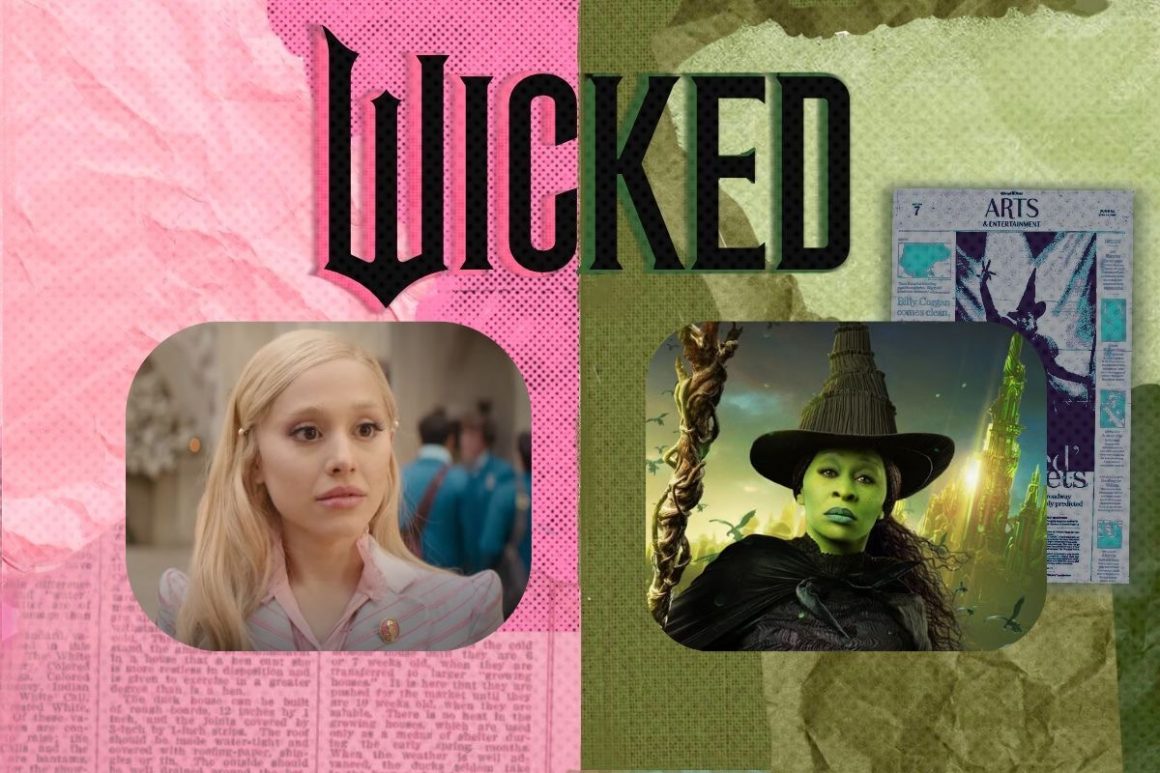
Movie Review: Wicked
By Grace Hagan, December 8 2024—
With over 100,000 hours of vocal performance, Italian pop singer Ariana Grande and Black, British thespian Cynthia Erivo are like the sun, pulling in the entire solar system of the theatre industry to watch Universal Pictures’ adaptation of Gregory Maguire’s 1995 book Wicked, based on L. Frank Baum’s 1900 series The Wonderful Wizard of Oz and the 1939 film adaptation. Wicked, composed by the American musical theatre lyricist, Stephen Schwartz, adapted Gregory Maguire’s book for Broadway. Grande was destined for the role of Glinda “Galinda,” the Good Witch of the North, when Joan Grande connected her with Kristin Chenoweth for the musical debut in 2003. They collaborated in 2016 for Broadway’s parody of the 1988 musical, Hairspray.
Wicked, released in November 2024 with a runtime of two hours and forty-five minutes, takes place in the Land of Oz, where the condescending, but classical in her mannerisms, Glinda, ostracizes Elphaba for her green skin at Shiz University. We are introduced to Glinda’s envy over Elphaba’s aptitude for sorcery, versus Glinda’s desire for perceived power. Fablelike imagery throughout the film historically contextualizes the role of the titular Wizard and Elphaba’s naive willingness to meet him and expand her magic, thus confirming the point of Glinda’s developing empathy as essential to critiquing authoritarianism, in place of remaining ostracized at Shiz University. Glinda is introduced in a bubble that floats as she classically sings “No One Mourns The Wicked” in a style similar to stream of consciousness, beginning the narrative in the middle of the story before using analepsis to introduce Glinda and Elphaba’s history. Such irony is whimsical, although it immediately sets the tone for a non-thespian to see singing and dancing as additives as opposed to vehicles for the character’s power, confirming a deeper understanding of their relationship as complicated, but evolutionary in its demand for reconciliation, as well as the ability to dream for unity among the chaotic nature of magic.
Grande does not appear complex in many roles she has partaken in. From her interpretation of Penny in Hairspray (2016) to Riley Bina in Don’t Look Up (2021), her perception of “upbeat” and “quirky” lacks evolution, especially in a headshot capturing Glinda during the Ozdust. Although with a sensitive ear, Grande vocally takes the lead. Erivo, an outstanding vocalist, reminds me of mere identical approaches to “I’m Here” in The Colour Purple (2015) in terms of tone and range when she sings on the cliff after Madame Morrible, a pedagogical sorcerer of weather with an “undulating Cloud-[shaped]” hairstyle, rightfully rejects Glinda as a subject to learn magic at Shiz University in place of Elphaba, characterizing the emotional tension between alchemy and its submission to a powerful sorcerer.
The set construction presents itself as critical of cultural ostracism. Munchkinland and the nine million tulips comprised of a rainbow have its citizens, Munchkinlanders, modelled after the actor, Ethan Slater “Boq,” running through the field announcing the death of the Wicked Witch of the East. Vanity announced the field was also in homage to The Wizard of Oz’s song “Somewhere Over the Rainbow,” implying that there maybe cultural barriers expected to be undermined throughout the film. For instance, Glinda’s stereotypically pink, feminine dress and crown in scene one inside a bubble that floats features a Fibonacci sequence as well as the yellow brick road. The cyclical aspect of the Fibonacci sequence is referenced again when Fiyero, Glinda’s love interest, dances on rotating, circular bookcases at Shiz University. Hence the integration of a Taj Mahal-looking palace amalgamated with Chinese architecture for Glinda and Elphaba’s dorm to support the reconciliation between Glinda and Elphaba, while she ironically sings “Popular.”
Signifiers of racism such as green skin, flying monkeys and Glinda meaningfully glancing at Elphaba while she lets her blonde hair flow in the wind, despite Elphaba initially complaining that it is cold, maybe interlinked with the allegorical message of the yellow brick road and the delusion Dorothy undergoes in the original, perhaps having a more positive connotation. The series originally contained silver shoes in Baum’s original book and debuted with ruby shoes in the 1938 film adaptation, “which was designed to show off the vibrance of Technicolor and stand in … contrast to the yellow brick road.” 2024’s Wicked references the silver shoes, so perhaps this may be a subtle confirmation of the cultural commentary the series makes if the yellow brick road Judy Garland gaily skips on is a whimsical, fantasy path.
Several articles and didactic videos referencing these props as “Easter eggs” may even be subtle hints of a drama epoch and biblical, satirical additives, which means that there is an inherent lighthearted nature between Glinda and Elphaba and their destiny in the Land of Oz. Overall, Wicked does a phenomenal job at revealing exploitative, cultural references such as fablelike imagery and the spiralling Fibonacci sequence throughout the costumes and architecture to represent the cyclical aspects of savage instinct and the bravery required to dismantle oppressive regimes.
